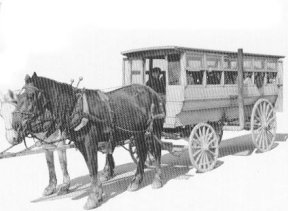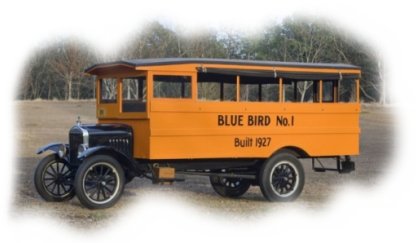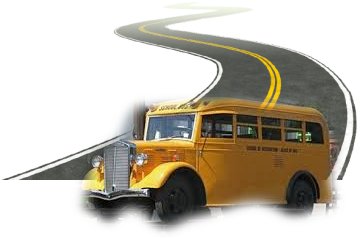
The stroll today is really more of a bus ride...so let's all hop on the bus
and see how it all got started.
THE SCHOOL BUS

I never rode a bus to school so when I got to go on one for school trips I thought it was exciting. Same thing for my son, we never lived far enough away for him to ride a school bus but he did go on school field trips and since I was chaperoning back then I didn't feel as excited as I did as a kid for some reason.
In 1869 the Commonwealth of Massachusetts passed the first legislation in the United States allowing the use of public funds for transporting school children. By 1919, with the passage of legislation in Delaware and Wyoming, forty-eight states had enacted similar laws. The primary reasons that states passed such legislation appear to be state-mandated, compulsory school attendance and the consolidation of public schools.

The standard means of transporting children to and from school in the nineteenth century was the school wagon, a modified farm wagon converted to carry pupils from the rural areas to the consolidated schools.
The first school buses were horse-drawn carriages known as “school hacks” or “kid hacks.” They were being made by Wayne Works starting around 1886, though it’s possible they were around earlier. However, you probably wouldn’t see teams of school hacks in every American town; many children had to rely on walking (uphill both ways through the snow), farm wagons, or sledges to get to school.
In 1914, with the popularity of automobiles rising, Wayne Works moved on to automobile chassis, allowing eager students to get to school faster. With these “buses” students would sit on the perimeter of the bus facing inward rather than toward the front as they do today. Afterwards, the Blue Bird Company began constructing a design for a bus that more closely resembles the buses that we know today, though they still had a long way to go.

In 1939, Dr. Frank Cyr rose to the occasion and organized a conference at the University of Manhattan in order to develop school bus standards. Prior to this, he had traveled the country observing the various types of school buses in use and safety precautions that they used, if any. The conference was funded by a $5000 grant (about $81,571 today) from the Rockefeller Foundation and attracted transportation officials from all 48 states in the Union at the time.

WHY ARE THEY YELLOW?
The result of the conference was 44 national standards for school buses being developed. One of these standards was school buses should be “national school bus glossy yellow”. Initially called “national school bus chrome,” the color was chosen because of its attention-grabbing qualities. It gets noticed faster than any other color. For instance, in one’s peripheral vision, studies have shown that humans notice the color yellow 1.24 times faster than another eye-catching color, red. Yellow is also particularly visible in the early morning and evening light, when school buses usually operate. The hope was that people would see the color of the bus quickly and know to slow down and be mindful of the children on board.
Thirty-five states within the U.S. switched to painting their buses this color soon after the conference, as did certain regions of Canada. But it wasn’t until 1974 that all school buses in the United States were painted this color.
The newer the school bus, the safer it is. School buses manufactured after 1992 have even more critical safety equipment such as additional emergency exits, better mirrors for the driver to be able to see around the bus, and swing-out stop arms to alert
motorists that children are getting on or off the bus.

As millions of children return to school on their own school bus let's wish them all safe trips.

Strolling Down Memory Lane with Candy - Main Page